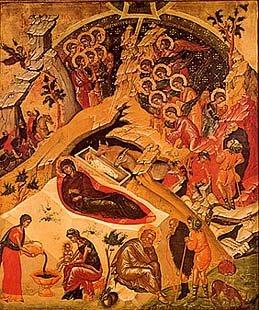Christmas
message, 2004
STYLIANOS
 Brother
Concelebrants and beloved children in Christ who is born, Brother
Concelebrants and beloved children in Christ who is born,
As we are all aware, there are two major saving events of
divine Providence which we celebrate every year with
appropriate gratitude and vigilance: Christmas and
Easter. These two are justifiably the climax of the
Church year; and they are by no means unrelated to each
other. The former is the presupposition of the
latter. And the latter is the steadfast goal of the
former.
The Incarnation of God that we celebrate at Christmas
would remain unfulfilled, and we could say unjustified, if
it did not culminate in the Crucifixion and Resurrection of
the only sinless God-Man, who is Christ. He came to earth
exactly as the Prophets had foretold: "behold the lamb of
God who takes away the sin of the world" (John 1:29).
Of course the image of the Lamb, namely the "lamb
slain from the foundation of the world" (cf. Rev. 13:8),
appears to be more suited to Holy Week and Easter. This is
because the Cross of Christ expresses more fully and
clearly the meaning of the redeeming sacrifice for
all of humankind. However, as we shall see, the 'spotless
lamb' is the central motif in the mystery of the divine
Incarnation. It expresses the love of God, which can
never be reciprocated. We can appreciate this better by
remembering the basic attributes of the Lamb.
The first attribute of the Lamb is humility - As
far as we know, there is no other animal in all of creation
which is more good-natured than the lamb. When sheared, it
offers no objection. When led to the slaughter, it follows
without protest, as if without suspicion about what lies
ahead. This is precisely why the loud-voiced Prophet Isaiah,
foretelling the 'utter humility' of Christ who was to come,
found no image from the created world more expressive of the
'divine-human' ethos, than the manner of an innocent
lamb:
"He was afflicted, yet he did not open his
mouth;
like a lamb that is led to the slaughter,
and like a sheep that before its shearer is silent,
so he did not open his mouth" (Is. 53:7).
The second attribute of the lamb is purity - if we
recall the comparison made in the Gospel between
sheep and goats (at the Second Coming of
Christ), we will notice an underlining of the fact that,
while goats have an untamed and rebellious nature,
the sheep always remain peaceful, which comes from their
deep innocence and tranquility.
It is clear that both the mentioned attributes of the
Lamb are strong symbols of the 'utter humility' of
Christ on the one hand, and His 'absolute sinlessness' on
the other. However, these two features of Christ's divine
and human person did not appear for the first time just
before the Cross and death. They were in fact the constant
characteristics that testified to the mystery of
'self-emptying' divinity from the very beginning of the
Incarnation and throughout His earthly life!
Even when He took the whip to drive the merchants from
the Temple, His anger was not hatred. It was
rather the Love that educates and saves. Even in that
moment of 'head-on collision', He remained unchanged in His
divine essence. This was also the case when Christ had the
most pointed confrontation with the hypocrisy and
disbelief of the people of the Law, expressed with
the repeated 'woes' recorded in the Gospel (cf. Matt.
23:13-39). For, it was an indisputable truth which He
proclaimed to all: "…learn from me, that I am gentle
and humble in heart, and you will find rest for your souls"
(Matt. 11:29). Exactly the same thing occurred when Christ
felt the need to reveal the height of His love for humankind
when consoling and supporting the weak and disheartened,
saying those completely unexpected words, "for I did
not come to judge the world, but to save the world" (John
12:47)!
After briefly 'deciphering' some of the meanings of the
Lamb both at Christmas and at Easter,
we can perhaps better appreciate the difference between the
'silence' of God and the 'noise' of the world.
Here, then, is the 'picture' that this year's Christmas
places before us:
The 'silence of the Lamb' contains all the
power and wisdom of God - that which St Paul
called "the mystery that was kept secret for long ages"
(Rom. 16:25). By contrast, the film 'Silence of the
Lambs' made by a modern Director implies, or rather
dramatizes, the cunning, distortion and tragic dead-ends of
people who have grown weary 'without God'.
In the past, the pious (regardless of which
religion they belonged to!), also showed love to their
fellow human beings. They would try to seek out the 'ways of
God' and follow them at least as much as they followed the
laws of nature.
Today, however, those who are impious are
offensively inhuman. They jostle with each other on the
world stage to see who will discover and 'secure' first the
'petrol routes' (and soon those of water as well!). This is
not only to control them, but also to
monopolise them. Nevertheless, the Lord lives. And
divine justice will not be delayed!
However, the salvation, which Christ brought to the
world, is never based on an 'ideology', nor is it a
conventional 'religion'. It is another manner of
existence. A 'strange mystery', literally. It is
the inexpressible miracle of the 'Word' in 'silence'! Of the
'fullness' that is 'emptied'! Of 'strength' in 'weakness'!
Of 'wisdom' in 'foolishness! And indeed the 'foolishness of
the Cross' (cf. 1 Cor. 1), which grants life through 'death'
alone.
To God the Word who was incarnate and born as a baby in a
manger for the sake of all people, be glory and worship unto
the ages. Amen.
With fervent prayers to the Lord
Archbishop S T Y L I A N O S
|

